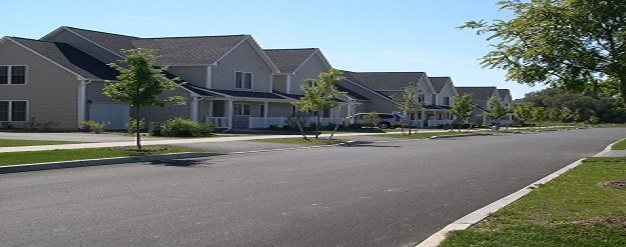Duplicitous Duplexes – Lets Party (Wall)!

By Darren Richards
Many cities in Canada, even in land-rich western prairie provinces like Alberta, are changing their land-use bylaws to allow more in-fill options to builders, developers and investors. They are also changing the rules to allow higher density housing, greater lot coverage, and style variations in older communities.
This is decidedly good news for builders and developers who are seeing margins shrink and profitably limited for single-detached in-fill opportunities. In fact, I have had clients here in Edmonton tell me they cannot make the numbers work if they are forced to build a single-family home after paying $400,000 – $500,000 to purchase the old house (to be demolished) and lot. The values are skewed even higher in places like Toronto and Vancouver.
It is decidedly good news for cities that are struggling to find the resources to service and maintain sprawling suburb developments. More new housing in the core of cities, higher density housing in existing communities, and of course the higher tax revenues from those communities are key motivations.
It is even good news for some buyers since a duplex home will inevitably be more affordable than a single-detached house on the same lot. They can live in a nice neighbourhood at a fraction of the cost.
However, for those buying duplexes, to live in or to rent, there are legal and practical issues that should be considered.
First, you need to know that you are entering into a form of joint ownership with a neighbor you may not even know. “What did you say” I’m buying my own half of a subdivided lot. It’s all mine!? Well, that’s mostly true. But you are actually sharing, in joint ownership, a shared wall between the two halves of the duplex (aka the “party wall”). It’s one thing to jointly own something of such keen value and importance with a spouse or parent or even with joint venture parties. But with strangers? Be aware. It may not be a fun party.
You can well imagine the legal implications flowing from that unique ownership arrangement. Both parties must share the cost of maintenance and replacement. More importantly, both parties have to agree on how to get that done. If you can’t agree, the owners must litigate or arbitrate. There will be no condominium board to regulate. Usually, if repairs are needed and the other party refuses to cooperate, the owner can proceed with repairs and then will have a builder’s lien on his neighbour’s half with respect to the costs.
Second, you are sharing access to and from private property with your neighbour as well. “What” I’ll agree to jointly own the party wall, but the rest of my property is my property!? Well, check out your province’s legislation or perhaps the “party wall agreement” that is likely registered against the title to your home. It likely grants an easement over your property to the benefit of the neighbouring duplex (and vice versa). This easement usually grants the other owner access to the extent required for the purpose of constructing, maintaining, repairing and rebuilding not only the party wall but any “extension wall” (i.e. those walls or roofs or other structures that adjoin or are in close proximity to the party wall).
Third, although the party wall may have a certain degree of fire rating (and under today’s building codes must), you are in very close space relationship with a person who may or may not have kept up their insurance payments. Again, the structure is not insured as it would be in a condominium scenario via condominium insurance. It is insured by each individual duplex owner so insurance risk is a potential issue. Even if there is insurance, where the mortgage lender for your neighbour’s property is concerned about their creditworthiness, they can scoop the insurance payment to payout the mortgage.
Fourth, you own your own parcel of land and building. “Isn’t that a good thing?!” Well yes, to a degree. But how many duplexes have you seen with one half beautifully landscaped, new siding, perhaps a new roof installed by the best residential roofers and the other side just about ready to fall apart, different siding altogether, roof leaking, fence falling over? Unless there is a restrictive covenant requiring the upgrading or maintenance of siding and the like, sovereign property ownership principals apply. Just like with neighbours owning single detached homes can make their own capital cost decisions if and when they like, so too can duplex owners. It just looks weirder and has a more material impact on the neighbouring property value. So, if they wanted to improve one house, and then later get in touch with a company similar to that of this Siding Contractor Minneapolis (or any siding installation company for that matter) to complete another property whenever they wish, they can do so at their own discretion.
Last, as with any shared space (condos and apartments fit here too), the quality of the party wall can impact the enjoyment of use. As one overheard conversation went: “My duplex neighbours are always banging on the wall and yelling at the top of their lungs until all hours of the evening even until midnight!?, “Does that not bother you!?” “Well not really. I’m usually practicing my drums until about then anyway”.
Duplexes are fantastic. And we will not soon see a decline in their popularity – for many good reasons. But please don’t buy one while blind to the issues. Have your realtor review any registered party wall agreement from the title. Also, try to meet the neighbours if you can. Or just buy the other half for your mother-in-law.
Darren Richards is a partner with Richards Hunter Toogood. He focuses on both residential and commercial Real Estate and Corporate/Commercial Law serving both small and medium-sized owner-managed businesses in the Edmonton and surrounding region. Mr. Richards also acts for major banking institutions and other lenders in relation to their commercial loan facilities. Reach him at: d.richards@rht-law.ca or www.rht-law.ca.
{{cta(‘7e3a1adc-814c-414c-9b99-ddd062307042’)}}




